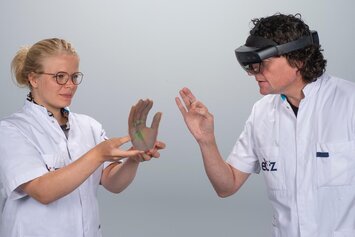It is a piece of pioneering research that Groenenberg is currently doing. Because a system like the one she "wrote" does not yet exist in the entire world. "A medical scan first of all maps out the patient's bones and blood vessels. And based on that information, the program compiles a hologram. What follows looks a bit like Superman's X-ray vision, because of the smart glasses that provide projection in 3D," the PhD student explains. "There are companies that do something similar. But with projections that don't move with the body part. With my technique, the hologram is really attached to the body, instead of a marker like a QR code. It ensures a 3D situation in the right place, even after shifting. This allows for faster, safer and more efficient surgery."
We Care for funding research
It is surgeons at the Elisabeth-TweeSteden Hospital (ETZ) who can already look into specific body parts of patients, without cutting into them. Groenenberg's research takes place in the 3D lab there. "I once did a 3-month internship there and just can't get away from it," she says, laughing. "Through We Care, a collaboration between the ETZ and Tilburg University, I received the financial resources for my further research. Multinational W. L. Gore & Associates is also investing in this project, allowing us to make it a complete PhD track. And through my supervisor Max Louwerse and Wendy Powell, both working for Tilburg University, I also have close contact with MindLabs. This is necessary, because I'm not there yet. My hologram now has a deviation of up to 1 centimeter. And to really be able to use my software during operations, I probably need to reduce the deviation to about 1 millimeter when moving."
Groenenberg also came up with the idea for this new technique years ago at the ETZ. "During my internship, my supervisor, vascular surgeon Jan Heyligers and I once had fifteen minutes to spare because a patient dropped out. We were philosophizing about where vascular surgery is going in the future. And it occurred to me how much it would help if you could "nudge" a specific vessel with Augmented Reality (AR) to get a better look. Jan is one of my promoters today and is also incredibly enthusiastic. That helps tremendously. He always says: if you think it can be done, try it out! And if I mention something about which I have doubts, he ensures that we can test it in practice." The 2 have now put in quite a few hours of research. For example, together with trauma surgeon Mike Bemelman and surgeon in training Lars Brouwers, they did a study on a hand, arm and leg that had been made available. Groenenberg: "Our technique is possible on anything, because the camera looks for the shape of the body part and recognizes it itself."
AR as a lubricant oil for surgery
The goal of her PhD? "First of all, I hope to gain many insights. But even though knowing is very nice, doing something with that knowledge is really great. I don't necessarily need a ready-made end product. But implementing something that I can then take further is what I'm hoping for. That 'something' could then lead to the use of less radiation, shorter operation times and therefore less risk of complications and infections. "A kind of lubricant oil for your operation. Because you see what's going on at the right time in the right place. Yes... I really have a great job!"
To achieve her goal, the PhD student uses the knowledge of many different parties. Among others, from parts of the MindLabs network. "The nice thing about that collaboration is that suddenly there are a lot of different contacts that I can consult for knowledge. Parties who can make holograms visually more attractive, for example. And don't forget the social side. Because ultimately we also need to measure how confident a surgeon is with this new technique. I have technical training myself, so I really need help with the other side of my research. Therefore a network like this is ideal." There are also much shorter lines now, the researcher explains. "I only have to tell them what I'm struggling with, and there is someone who can and wants to help me." The PhD candidate, in turn, gives back to the network, by the way. "Through the contact I suddenly realized, for example: with holograms you can also make education more fun and put knowledge in a different perspective. And so I recently gave an explanation at ROC Tilburg on how to make them. All in all, a nice interaction."

